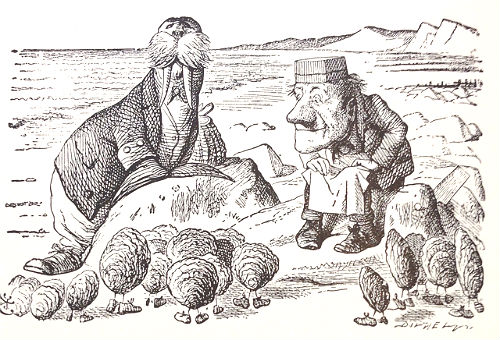
It is with great pleasure that I share today’s post with you from a fellow fan of Instagram that I respect and admire a great deal.
Ann Handley is a long time friend who is not only smart, funny and a great keynote speaker, but she is also the Chief Content Officer at MarketingProfs. An amazing writer, Ann is the best-selling co-author of Content Rules and the author of a new book that I highly recommend: Everybody Writes: Your Go-To Guide to Creating Ridiculously Good Content (due out Sept 15).
On top of all that, Ann is a regular contributor to many of the conference eBooks we produce and has had us create one for MarketingProfs in the past. I’m excited to say we’ll be creating one for the MarketingProfs B2B Forum this year as well, covering “What’s Next” in B2B marketing.
Today’s post is an extended version of her contribution to the Audience Development for Content Marketing eBook we published for CMWorld recently. Enjoy!
 Tweedledee tells Alice a story about The Walrus and The Carpenter, who happen upon a bed of oysters and invite them on a journey—to walk and talk together along a briny beach.The eldest oyster declines the invitation:
Tweedledee tells Alice a story about The Walrus and The Carpenter, who happen upon a bed of oysters and invite them on a journey—to walk and talk together along a briny beach.The eldest oyster declines the invitation:
But four young Oysters hurried up,
All eager for the treat:
Their coats were brushed, their faces washed,
Their shoes were clean and neat—
And this was odd, because, you know,
They hadn’t any feet.
When Lewis Carroll wrote that 143 years ago in Through the Looking-Glass, he couldn’t have fathomed that we’d be talking about his little oysters in a content marketing context. But Carroll’s tale is a handy metaphor for the power of story in growing oysters… err, audience.
How so?
Trust builds connection. The little oysters followed—“All hopping through the frothy waves, and scrambling to the shore”—because they trust their leaders and because they are eager to share in what appeared to be an epic journey of sorts. When The Walrus and The Carpenter stopped to rest on a rock, the little oysters stopped, too, and “waited in a row.”
Content marketing takeaway: Are you merely stuffing a pipeline full of leads? Or are you building an audience who will rely on you for information, advice, and help, and will seek out your expertise? Is your thought leadership truly… well, leading?
Great narrative reaches your audience’s audience. The Walrus and The Carpenter lead the young oysters for a mile or so, along the way collecting four other oysters, and yet another four—“And thick and fast they came at last/and more and more and more.”
The word spreads because it’s impossible to resist a good story. You know this as well as I do because you, too, are human. But, refreshingly, in this case the journey itself also feels part of something bigger—larger than the little oysters themselves.
Content marketing takeaway: Are you creating content worth sharing? Are you inspiring your audience to share your story for you? Are you leading them on a journey and into a relationship? Or are you talking too much about what you do or what you sell and not enough about what it does for them? Are you creating a bigger story that your customers can feel part of?
Your words are your emissaries. It’s poetry, the way the Walrus and The Carpenter communicate with their audience. The time has come, the Walrus says at one point: “To talk of many thing: Of shoes—and ships—and sealing wax—Of cabbages—and kings—And why the sea is boiling hot—And whether pigs have wings.”
The language is spare, but still it paints a vivid and evocative picture, doesn’t it? It captures the attention of the little oysters. (I almost wrote that it captures their hearts, too, but do oysters have hearts? I’m not sure.)
Content marketing takeaway: In Looking-Glass, the words are literally poetry. But the larger takeaway for marketers is to step up your writing. Words are our emissaries and ambassadors, carrying important messages for us. Yet businesses often neglect or overlook words—much to their own detriment.
Think of it this way: If a visitor came to your website without its branding in place (logo, tagline, and so on), would he or she recognize it as yours? If you stripped your branding from all your properties and lined up your words alongside a competitor’s, would you recognize yourself? Would you stand out?
So the question becomes: Are you telling your story from your unique perspective, with a voice and style that’s clearly all you?
I’ve taken some liberties with Lewis Carroll’s oyster story. Because at the end of the journey, a mile down the beach, far from the bed they called home, the fat little oysters become lunch. The Walrus and The Carpenter douse them with pepper and vinegar and swallow them up with some bread thickly smeared with butter.
None of us wants to swallow our customers whole, of course. And although there might be an analogy I could make here about oysters and audiences and lunch and ROI, that’s better left as the subject of another installment!
Image source: Illustration by John Tenniel from Through the Looking-Glass and What Alice Found There by Lewis Carroll (Random House, 1965 Centennial Edition, from Ann Handley’s library).
You can connect with Ann on Twitter @annhandley – @marketingprofs and over at her blog, Ann Handley.


